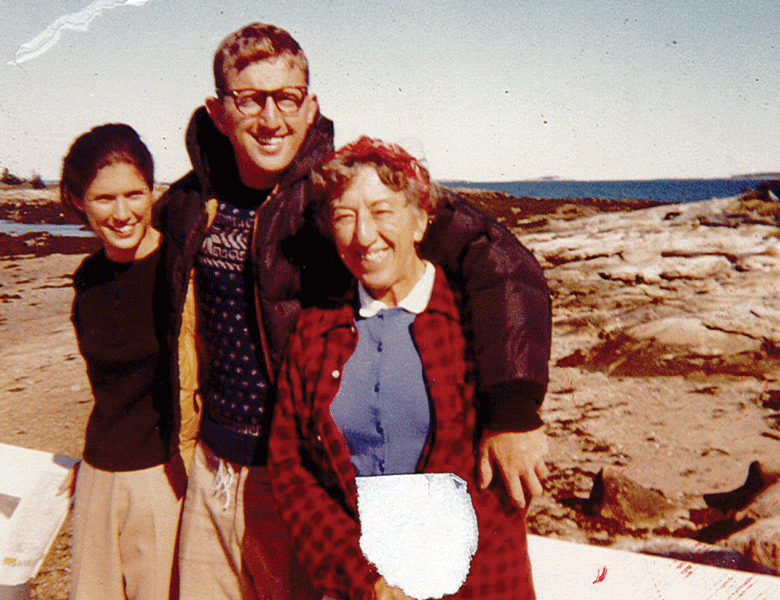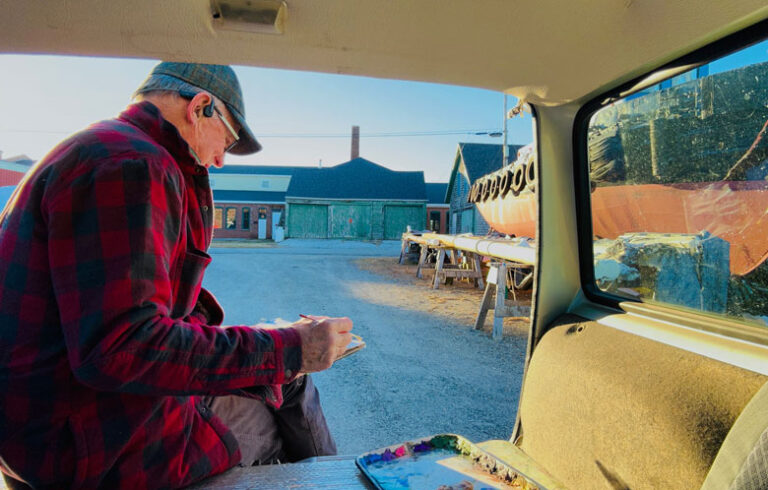Tour boat operators sometimes entertained their passengers by referring to Cape Island as “Witch’s Island.”
That’s because the primary resident there, during summers from 1961 to 1985, was Margaret Hamilton, the actor who played the Wicked Witch of the West and Elmira Gulch in the 1939 film The Wizard of Oz.
Contrary to her character, one of the top villains in movie history, Hamilton was known by her mainland neighbors, in Maine and everywhere else, for her sweet nature.
Cape Island is located off the tip of the tiny village of Cape Newagen, which is itself on the larger island of Southport, south of Boothbay. According to the Boothbay Historical Society, the Boothbay region has a settlement history going back to the early 17th century, when English fishermen and farmers settled there. The islands were considered excellent outposts for keeping the harbor and mainland safe from French privateers.
Hamilton and her son, Hamilton “Ham” Meserve, bought Cape Island in 1961. The 20-acre island is about 900 feet from the mainland and has a farmhouse built in 1852. Meserve and his wife, Helen, later bought property in Cape Newagen, where they now live.
Born in 1902 in Cleveland, Ohio, Hamilton made her acting debut in high school theater. But before pursuing acting further as a career, her parents insisted she first go to college to be sure she would have an alternative for earning a living, so she trained as a kindergarten teacher and taught elementary school in Boston and New York.
Her professional acting debut came on the New York stage in 1932. She went to Hollywood the following year. Talkies were uprooting silent films, and Hamilton’s excellent diction (“She could speak the King’s English,” said Meserve) paid off. She was already working for MGM when her agent called with the studio’s offer of the part of the witch.
Hamilton continued acting regularly, for film, television, stage and radio until 1982. She was a natural for TV, said Meserve.
“At first, movie actors couldn’t handle live TV, where there were no ‘cut and retake,’ but she knew how to ad lib,” he said. “She was known as a pro’s pro. She was extremely well respected within the industry. And she shunned star status.”
Hamilton had an apartment on Gramercy Park in New York City and an estate in Dutchess County, N.Y. She connected with Maine through her summer stock theater work, and eventually decided to look for a summer home to buy. She heard that lighthouses were being sold off by the government, most recently Hendricks Head on Southport Island, and thought buying one would be fun. With Ham and Helen, who had just returned from their honeymoon, she visited the area and found instead that Cape Island was for sale.
“So Mom and I cleaned out our savings accounts and bought the place,” said Meserve, the actor’s only child.
Meserve, a retired financier and newspaper publisher and a long-time partner with Running Battle Antiques in Millbrook, N.Y., was 3 when The Wizard of Oz was filmed in 1939. Despite his mother’s fame, he had a normal childhood, thanks to her vigilance.
“She protected me,” he recalled. “She knew what child actors went through. She was very close to Judy Garland and saw what happened to her.”
A passionate advocate for causes that benefited children and animals, Hamilton had a tender heart, Meserve said. One of her concerns was the effect her Wicked Witch role had on youngsters.
“Little Johnny would be cowering behind his mother’s skirts, and that’s when Mom would get down on her knees and coax him around and say, ‘Hi, I’m just a nice lady,’” recalled Meserve.
By the time she took up summer residence on Cape Island, Hamilton was in her 60s. She quickly became a well-loved fixture on this part of the Maine coast. She was known for rowing between the island and the mainland.
“Lobstermen loved the fact that this famous gal was rowing out there by herself, and they kind of adopted her and looked after her,” Meserve said. “She got to know everyone in town. She was very outgoing. People loved the idea that she was there and had adapted to life there.”
One of those trips almost ended in disaster. It was the end of the season, and Hamilton was rowing over to meet a taxi to take her to the Portland airport, where she would fly back to New York City. But the inn’s caretaker had already brought up the floats, leaving Hamilton to climb up a ladder to the dock.
“It was very low tide,” Meserve said. “Mother tied up the rowboat, reached across, and went into the water. She said the coat was weighing her down. She didn’t know what she would do. When the taxi arrived, no Miss Hamilton. Then he had a premonition to walk to edge of dock and look down and pulled Mom out.”
The driver took her to the caretakers’ house.
“Euphemistically, they put half a pint of cough medicine into her,” Meserve said.
Hamilton’s time on the island depended on her work schedule, but she tried to arrive by July, traveling back and forth between gigs, and often having friends stay with her.
The island was a wonderful refuge from the busy acting life. She liked to knock around in sneakers and blue jeans. There was no electricity, so she had kerosene lamps and stoves.
“She loved it,” Meserve said. “Living alone, she would come home from the theater at about 2 o’clock, all adrenaline. It would take three hours to come down. One way she did that was to clean house. She loved the island because it was her house. She loved the rocks, she loved the water. She’d bring in the wood for the fire.”
Hamilton died in 1985. Today, said Meserve, the island is a happy scampering ground for his children and grandchildren and their friends.
“They absolutely adore it,” he said.
As for those folks who call it “Witch’s Island?”
“We don’t mind,” said Meserve. “It’s part of the fabric of the area.”





